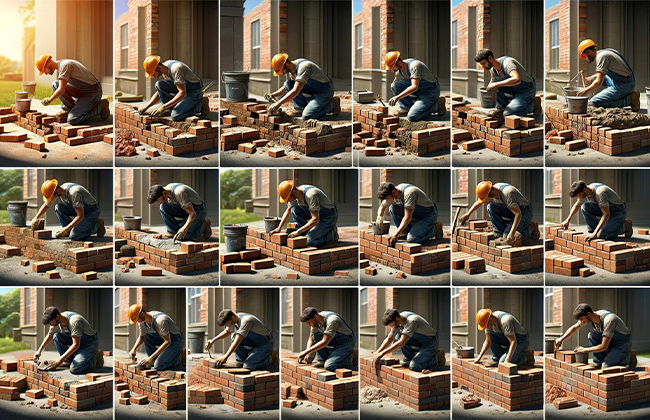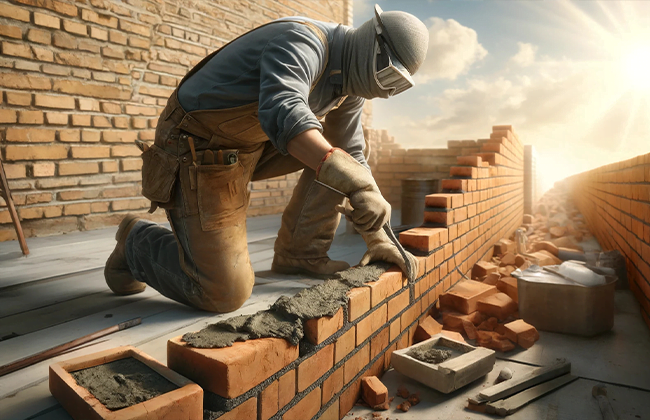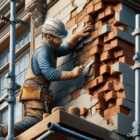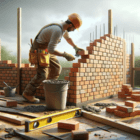When it comes to maintaining the structural integrity of your home or building, understanding how to repair loose bricks is essential. Loose bricks not only compromise the aesthetic appeal of your property but also its safety. This guide provides a comprehensive approach to secure and repair your brickwork effectively, ensuring that your structure remains robust, secure, and visually appealing.
Table of Contents
What Causes Bricks to Become Loose?
Loose bricks can result from a variety of factors, each contributing to the weakening of your structure’s integrity. Understanding these causes can help in preventing damage and choosing the right repair methods.
Weathering and Aging
Over time, bricks and mortar are subjected to the relentless forces of nature. Rain, snow, and cycles of freezing and thawing temperatures all play a role in slowly eroding the mortar. This deterioration isn’t just about aesthetics; it’s about the gradual loss of the mortar’s binding ability, which can eventually lead to bricks becoming loose or even falling out. Regularly checking for weather-induced wear and tear is essential for timely maintenance.
Substandard Mortar Mix
The quality of the mortar mix used initially in laying the bricks significantly impacts the longevity of the brickwork. If the mix was off—with too much sand or not enough lime, for example—it won’t hold the bricks as securely as it should. Over time, this subpar mix can lead to mortar crumbling, which in turn allows bricks to shift, loosen, and become unstable. It’s crucial to use the right mortar mix when making repairs to ensure that the new work lasts.
Physical Impact
Bricks can become loose due to physical impacts. This could be from a vehicle accidentally backing into a wall, heavy machinery operating nearby causing vibrations, or even during construction activities where heavy loads or equipment bump against brick walls. These impacts can dislodge bricks, especially if the mortar is already weakened from other issues. Implementing protective measures and minimizing direct impacts to brick walls can reduce this risk.
Moisture Intrusion
One of the most destructive forces for brickwork is moisture intrusion. Water that seeps into the bricks and mortar can freeze when temperatures drop, expanding and creating pressure within the wall. This expansion can force bricks to move out of place and loosen over time. Proper sealing and regular inspections for cracks or gaps can help prevent water from penetrating the brickwork and causing damage.
Understanding these factors allows for more informed decisions when addressing repairs and can help extend the life of your brick structures. Regular maintenance, using quality materials, and addressing any damage promptly are key to keeping brick walls secure and looking their best.
Detailed Diagnosis of Loose Bricks
Understanding the underlying issues with your brickwork starts with a thorough diagnosis. Here’s how you can pinpoint problems and decide on the next steps for repair.
Visual Inspection
Start with a close examination of the brickwork. Look for obvious signs of damage, such as:
- Small Cracks: These often appear near joints or at stress points within the wall. Small cracks might seem minor but can deepen and widen if ignored.
- Missing Mortar: Gaps in the mortar are clear indicators that repairs are needed. These gaps can allow moisture to infiltrate, exacerbating the problem.
- Uneven Bricks: Check if any bricks are protruding or receding from the wall line. This unevenness can be a sign of underlying shifts or settling.
- Efflorescence: White, powdery residue on the bricks indicates water seepage. It’s not just a cosmetic issue; it’s a clue that moisture is affecting your wall.
Taking note of these issues early can save you from more extensive and expensive repairs down the line. Regular visual inspections should be part of your routine maintenance.
Structural Assessment
If your visual inspection reveals significant issues, it may be time to consult a structural engineer. Here’s what this process typically involves:
- Severity Evaluation: A professional can assess how deep and severe the damage is, going beyond surface-level issues. They can determine whether the problems are aesthetic or structural.
- Root Cause Analysis: Engineers can help identify not just the symptoms of the damage but also the underlying causes—be it poor construction, environmental factors, or other stresses.
- Repair Plan: Based on the assessment, you’ll get recommendations on the necessary repairs or even a complete reconstruction if needed. This plan will ensure that any work done addresses both the symptoms and the causes.
Getting a structural assessment can prevent future problems by ensuring that all repairs contribute to the stability and longevity of your brickwork. Engaging experts not only helps in diagnosing the issues accurately but also in implementing the most effective solutions.
Choosing the Right Materials for Repair
Selecting the appropriate materials is crucial for ensuring that your repairs are effective and enduring. Here’s how to choose the right bricks and mortar for the job.
Types of Bricks and Mortar
- Matching Existing Bricks: The new bricks should match the existing ones in material, color, and texture to maintain the structural integrity and visual harmony of your building. For historic or older buildings, you might need to source reclaimed bricks that align with the original construction.
- Mortar Selection: Choosing the right type of mortar is just as important. For most residential projects, Type N mortar is recommended due to its medium strength and good adhesion properties, making it suitable for above-ground applications. In areas with severe weather conditions, consider using Type S for enhanced durability.
- Compatibility: Ensure that the mortar’s thermal expansion coefficient and permeability match those of the existing bricks. This compatibility prevents premature deterioration due to environmental stresses.
Understanding these material nuances can greatly influence the success of your repair work, ensuring that the fixes last as long as possible while blending seamlessly with the original structure.
Tools for the Job
Equipping yourself with the right tools not only makes the repair job easier but also ensures that it is done safely and efficiently. Here’s what you’ll typically need:
- Basic Tools: A chisel, hammer, and trowel are essential for removing old mortar and applying new mortar.
- Mortar Hawk: This tool is handy for holding mortar while you work, making the application process smoother and faster.
- Pointing Tool: Essential for achieving clean, professional-looking joints. Pointing tools come in various shapes and sizes, allowing for precision work.
- Safety Gear: Safety glasses, gloves, and a dust mask are crucial to protect yourself from brick dust and debris during the repair process.
By preparing with the right materials and tools, you can tackle brick repairs confidently, ensuring lasting results and maintaining the beauty and safety of your building.
Step-by-Step Guide to Repairing Loose Bricks

Repairing loose bricks is a meticulous process that, when done correctly, can significantly extend the lifespan of your brickwork. Here’s a detailed, step-by-step guide that includes a table of the necessary materials.
Materials Needed
Here’s a table of the basic materials and tools you’ll need to carry out the repairs:
| Material/Tool | Purpose |
| Replacement bricks | To replace any that are damaged beyond repair |
| Mortar mix | To bind the bricks securely in place |
| Chisel | To remove old mortar and loose bricks |
| Hammer | To assist in removing bricks and old mortar |
| Trowel | To apply and shape new mortar |
| Mortar hawk | To hold mortar while working |
| Pointing tool | To finish joints for a clean look |
| Brush | To clean debris from bricks and wall cavity |
1. Preparing the Area
- Remove the Loose Bricks: Use the chisel and hammer to carefully remove any bricks that are loose. Make sure to clean out all the old mortar from both the bricks and the wall cavity. This step is crucial for ensuring that the new mortar adheres properly.
- Clean the Bricks: If you plan on reusing the original bricks, scrub them thoroughly to remove any remaining mortar. This helps in maintaining the consistency and appearance of your wall.
2. Mixing the Mortar
- Prepare the Mortar Mix: Use the manufacturer’s instructions to mix the mortar to the right consistency. The mortar should not be too wet or too dry; it needs to hold its shape when pressed.
3. Replacing the Bricks
- Apply Mortar: Apply a generous amount of mortar to the cleaned cavity and to the base of the brick to ensure good adhesion.
- Place the Brick: Carefully insert the brick into the cavity. Press it firmly into place, making sure it aligns with the surrounding bricks.
- Tool the Joints: Once the mortar is just hard enough to not stick to your finger (thumbprint hard), use the pointing tool to smooth and seal the joints. This step is vital for weatherproofing the repair.
4. Curing
- Curing Process: Allow the mortar to cure according to the recommendations, usually for about 24 to 48 hours without disturbance. Protect the area from direct water spray and extreme weather conditions to ensure the mortar sets properly.
Following these steps carefully will help you repair loose bricks effectively, preserving the structure and aesthetics of your brickwork. Regularly check your brick structures for signs of damage and address them promptly to maintain their integrity and appearance.
Preventative Measures and Maintenance
Maintaining your brickwork requires ongoing attention to prevent damage and prolong the structure’s life. Here are some preventative measures and maintenance tips that are essential for keeping your brickwork in top condition.
Regular Inspections
- Why Inspect: Conducting regular inspections helps catch potential issues before they become major problems. It’s much easier to fix a small area of damaged mortar than to rebuild a wall that has suffered extensive damage due to neglected maintenance.
- How Often: Ideally, inspect your brickwork at least twice a year. Additional checks after severe weather events like heavy rains, freezing temperatures, or storms can help you identify and address damage caused by the elements.
Effective Drainage
- Importance of Drainage: Proper drainage is crucial to protect your brickwork. Water accumulation can lead to significant issues, such as mortar erosion or foundation problems, both of which can cause bricks to loosen or walls to shift.
- Improving Drainage: Ensure that gutters and downspouts are clear of debris and that water is directed away from your home’s foundation. Consider installing French drains or adjusting the landscape to better manage water flow around your property.
Sealant Application
- Why Use Sealants: Applying a breathable sealant can extend the life of your brickwork by preventing moisture from penetrating the bricks and mortar while still allowing the wall to vent moisture.
- Choosing the Right Sealant: Select a sealant that is appropriate for your specific type of brick and climate. It should provide moisture protection without trapping water inside, which can exacerbate freezing and thawing damage.
- Application Tips: Apply sealant during dry, mild weather. Make sure the brickwork is clean and dry before application to ensure the sealant adheres properly and performs as expected.
By integrating these preventative measures and maintenance routines into your upkeep schedule, you can significantly enhance the durability and appearance of your brickwork. Regular care not only keeps your property looking its best but also helps avert costly repairs in the future.
Conclusion
Repairing loose bricks is a vital task for maintaining the safety and aesthetics of your property. Should you find the repair process daunting or if the damage appears extensive, it might be prudent to seek professional assistance. For expert help, feel free to reach out to us at (+1) 917-355-8556. Our team is equipped to address all your concerns and provide top-notch service in repairing loose bricks, ensuring your structure’s longevity and stability.
FAQs
Q: What are the common causes that lead to the need to repair loose bricks?
A: Common causes that necessitate the repair of loose bricks include environmental wear from elements such as rain and temperature fluctuations, substandard mortar quality, physical impacts from construction activities or accidents, and moisture intrusion that weakens the mortar. Recognizing these factors early can help in applying the correct repair techniques.
Q: How frequently should I inspect my property to ensure I don’t need to repair loose bricks?
A: It is wise to inspect your property for loose bricks at least twice a year. If your area experiences severe weather or if you have previously noted issues, more frequent inspections might be necessary. Regular inspections facilitate early detection and simplify the repair process, helping to maintain the building’s structural integrity.
Q: What materials are essential when I need to repair loose bricks?
A: When you need to repair loose bricks, you will require replacement bricks that match the existing brickwork, an appropriate mortar mix for bonding, and tools such as a chisel, hammer, trowel, and pointing tool. Choosing the right materials ensures that the repairs integrate well with the original structure and are durable.
Q: Can I repair loose bricks myself, or should I hire a professional?
A: If the repair of loose bricks involves minor fixes and you are comfortable with basic masonry work, you might handle it as a DIY project. However, for significant damage or structural concerns, hiring a professional is advisable. A professional can provide a thorough assessment and carry out repairs that ensure long-term safety and durability.
Q: What are the ideal weather conditions for repairing loose bricks?
A: The best conditions for repairing loose bricks are dry, mild weather. Such conditions ensure that the mortar sets properly and adheres effectively to the existing bricks. Avoid undertaking repairs during rainy or very cold weather, as these conditions can negatively impact the curing of the mortar and the quality of the repair.




